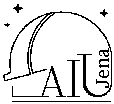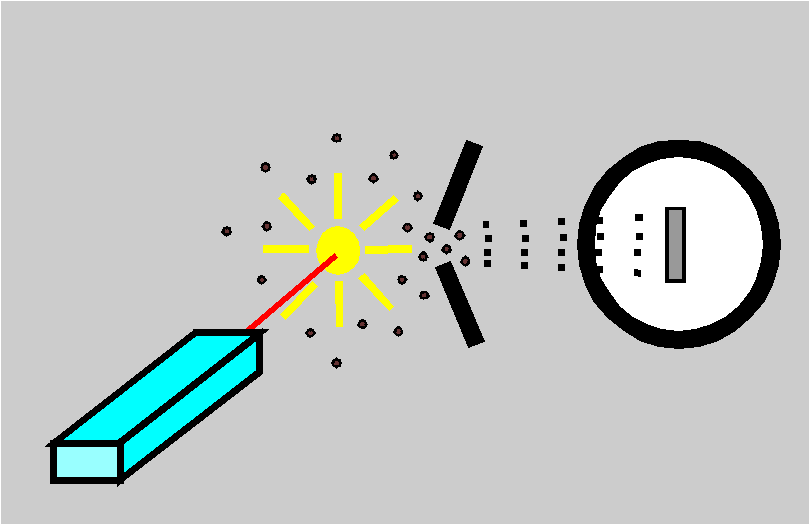
|
Intro
Laboratory astrophysics is one of the youngest branches of astrophysics. Its name was coined about 30 years ago in order to denote the investigation of the solid phases in astrophysical environments by laboratory simulation experiments. Today, this new field has developed to a kind of galactic material science.
Main topics of this field are:
- the absorption and emission spectra of dust, molecules, ions, and radicals
- the "mineralogy" of dust particles and its relation to their optical properties
- reactions of molecules and ions in the gas phase as well as on grain surfaces
- interaction of dust grains with UV and ion radiation as well as heat, leading to structural changes
- properties of interplanetary dust, cometary and meteoritic grains
- aggregation, growth and destruction of dust grains leading to planet formation
The Astrophysical Institute of the University of Jena belongs to the "early birds" in developing laboratory astrophysics. In the last decade, an "Chemical and spectroscopical lab" as well as a "Dust lab" have been established. The latter has been moved in 2004 to the IGEP, TU Braunschweig.
Research
Subject of our research are the refractory constituents of the cosmic dust, which comprises very different materials. Most of them are also technically important and subject to intensive investigation in solid-state physics, materials research and physical chemistry.
Some popular description (in German) can be found in
- J. Dorschner, H. Mutschke, ``Das staubige Universum und die Festkörper-Astrophysik'', Sterne und Weltraum 6/1996, 443-451.
- H. Mutschke, J. Dorschner ``Moderne Materialwissenschaft im astrophysikalischen Labor'', Sterne und Weltraum 6/1997, 546-555.
- H. Mutschke, C. Jäger, Th. Posch ``Neue Erkenntnisse zur Mineralogie des kosmischen Staubes'', Astronomie + Raumfahrt 41 (2004), 9-13.
A detailed description of our current research activities including collaboration and further links.
See also our List of Publications.
Here you find the Optical Databases containing optical constants of materials measured in our lab.
Collaboration, Funding
A second Astrophysical lab focussing on cluster physics has been opened in 2003 at the Institute for Solid State Physics in collaboration with the Max Planck Institute for Astronomy, Prof. Thomas Henning.
In 2000-2006, both Jena labs have been working together with laboratories in Chemnitz, Dresden, Heidelberg, and Leiden within a Research Unit "Laboratory Astrophysics" (FGLA) funded by the DFG.
Since 2010, DFG is funding one project each in both Jena labs within the SPP (priority programme) 1385: The first 10 Million Years of the Solar System - a Planetary Materials Approach
Collaboration on optical properties of particle aggregates and meteoritic grains: NORDITA Copenhagen, Dr. Anja C. Andersen
Collaboration on astromineralogy of oxide grains and AGB stars: Institut f. Astronomie der Univ Wien, Dr. Thomas Posch
Collaboration on the Database of Optical constants: Astronomical Institute of the St. Petersburg State University, Dr. Vladimir Il'in
Members
- Staff:
- Dr. Harald Mutschke
- Dr. Cornelia Jäger
- CTA Gabriele Born
- Postdoc:
- PhD Students:
- Dipl.-Phys. Simon Zeidler
- Diploma Students:
- Chris Kämmerle
- Former Group Members:
- until Jan. 2010: Dr. Kamel A. Khalil Gadallah
- until Feb. 2010: Dr. Akemi Tamanai, now at Kirchhoff-Institut Heidelberg
- until Dec. ´06: Dr. Isabel Llamas Jansa, now at IFE Lillestrom, Norway
- until Sept. ´06: Dipl.-Phys. Walter Teuschel, retired but still keeping our instruments working
- until June ´06: Dipl.-Phys. Susann Hummel, now at EADS Munich
- until Aug. ´04: Dr. Johann Dorschner, retired but still active
- until July ´04: Dr. Angela Staicu
- until July ´04: Dr. Oleksandr Sukhorukov
- until Feb. ´04: Dr. Ewa Diegel
- until Feb. ´03: Dr. Dominik Clément
- until Jan. ´03: Dr. Gael Rouillé
- until Nov. ´02: Dr. Dirk Fabian
- until May ´02: Prof. Dr. Th. Henning, now at MPIA Heidelberg
- until March ´02: Dr. Shantanu Rastogi
- until Dec. ´98: Dr. Martin Schnaiter, now at IMK Karlsruhe
- until Oct. ´98: Dr. Anja Braatz
- until Dec. ´96: Dr. Birgit Begemann
